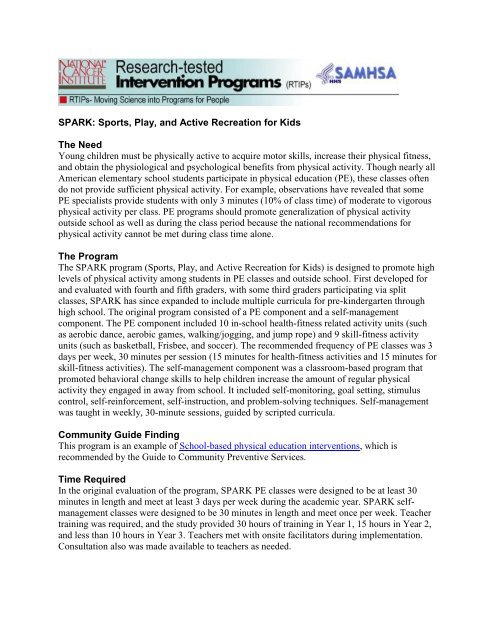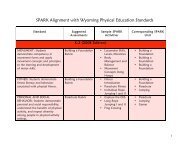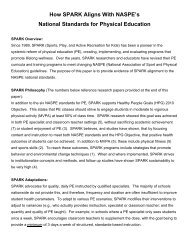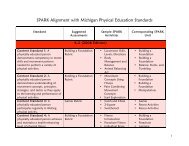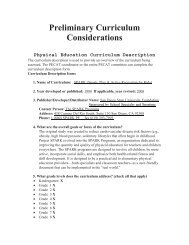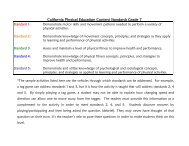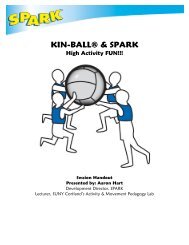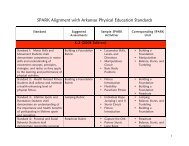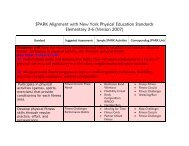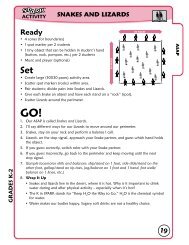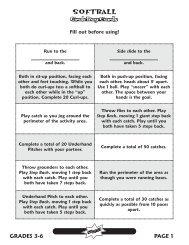5-a-Day Power Plus Program Summary - Spark Physical Education
5-a-Day Power Plus Program Summary - Spark Physical Education
5-a-Day Power Plus Program Summary - Spark Physical Education
You also want an ePaper? Increase the reach of your titles
YUMPU automatically turns print PDFs into web optimized ePapers that Google loves.
SPARK: Sports, Play, and Active Recreation for KidsThe NeedYoung children must be physically active to acquire motor skills, increase their physical fitness,and obtain the physiological and psychological benefits from physical activity. Though nearly allAmerican elementary school students participate in physical education (PE), these classes oftendo not provide sufficient physical activity. For example, observations have revealed that somePE specialists provide students with only 3 minutes (10% of class time) of moderate to vigorousphysical activity per class. PE programs should promote generalization of physical activityoutside school as well as during the class period because the national recommendations forphysical activity cannot be met during class time alone.The <strong>Program</strong>The SPARK program (Sports, Play, and Active Recreation for Kids) is designed to promote highlevels of physical activity among students in PE classes and outside school. First developed forand evaluated with fourth and fifth graders, with some third graders participating via splitclasses, SPARK has since expanded to include multiple curricula for pre-kindergarten throughhigh school. The original program consisted of a PE component and a self-managementcomponent. The PE component included 10 in-school health-fitness related activity units (suchas aerobic dance, aerobic games, walking/jogging, and jump rope) and 9 skill-fitness activityunits (such as basketball, Frisbee, and soccer). The recommended frequency of PE classes was 3days per week, 30 minutes per session (15 minutes for health-fitness activities and 15 minutes forskill-fitness activities). The self-management component was a classroom-based program thatpromoted behavioral change skills to help children increase the amount of regular physicalactivity they engaged in away from school. It included self-monitoring, goal setting, stimuluscontrol, self-reinforcement, self-instruction, and problem-solving techniques. Self-managementwas taught in weekly, 30-minute sessions, guided by scripted curricula.Community Guide FindingThis program is an example of School-based physical education interventions, which isrecommended by the Guide to Community Preventive Services.Time RequiredIn the original evaluation of the program, SPARK PE classes were designed to be at least 30minutes in length and meet at least 3 days per week during the academic year. SPARK selfmanagementclasses were designed to be 30 minutes in length and meet once per week. Teachertraining was required, and the study provided 30 hours of training in Year 1, 15 hours in Year 2,and less than 10 hours in Year 3. Teachers met with onsite facilitators during implementation.Consultation also was made available to teachers as needed.
Intended AudienceThe original audience for this program was fourth- and fifth-grade elementary school studentsand their PE teachers. Additional curricula, professional development, and followup supportmodels have been developed since the initial study.Suitable SettingsWhile SPARK was originally developed for elementary school settings, newer versions are nowavailable for early childhood, kindergarten through grade 2, middle school, high school, and afterschool.Required ResourcesThe materials for SPARK have been updated since the original evaluation and can be obtainedby contacting the developer. The central product is the SPARK PE curriculum, presented in athree-ring binder for easy access to lessons. Additional required materials include a media discthat holds supplemental skill and task cards, assessment tools, “Homeplays,” and more; a musicCD created specifically for the SPARK content and activities; and a SPARKfolio that provideshard copies of the content provided on the media disc.About the StudySeven elementary schools participated in the study in the first year, and another control school(N=4) was added during the second year. The schools were stratified into two groups by thepercentage of minority students. Within each stratum, one school was randomly assigned to eachof the three experimental conditions: specialist-led, teacher-led, or usual PE control. Thespecialist-led condition included three certified PE specialists. Classroom teachers in the teacherledcondition participated in training to become familiar with the curricula and to develop theclass-management and instructional skills needed to implement the two SPARK componentseffectively. Generalist teachers and specialists from the intervention conditions received ongoingtraining and supervision. Over the course of the academic year, fourth- and fifth-grade studentsin both intervention conditions participated in 30-minute PE classes at least 3 days per week andreceived weekly self-management classes. Principals of control schools were asked to continuewith usual PE programs during the study.The 955 students who participated in the study were in fourth grade at the beginning of the 2-year intervention; the ethnic distribution was 82% White, 12% Asian/Pacific Islander, 4%Latino, and 2% Black. Fifty-three percent were male, and the average age was 9.5 years.The outcome measures were administered at the beginning and end of each school year. TheSOFIT (System for Observing Fitness Instruction Time) was used to make direct observationsabout the amount of PE per week the students engaged in, as well as children’s level of physicalactivity. The mile-run test and 60-second sit-up test were used to measure cardiorespiratoryendurance and abdominal strength and endurance, respectively.Posttest scores, adjusted for baseline age and baseline values, were analyzed using modified onewayanalyses of variance (ANOVA) to test for differences among the three experimental groups.The ANOVAs were modified to account for clustering of values within schools, because schoolwas the unit of assignment.2
Key FindingsEffects on <strong>Physical</strong> ActivityStudents in both the specialist-led condition and the teacher-led condition participated insignificantly more minutes of moderate to vigorous physical activity per week (p
Effects on Amount of PEStudents in both intervention conditions participated in more frequent PE classes perweek at posttest compared to students in the control condition (p
Effects on Abdominal Strength and Endurance and Cardiorespiratory EnduranceGirls in the specialist-led condition had superior abdominal strength (p=.03) andcardiorespiratory endurance (p=.03) at posttest compared to girls in the control condition.There were no significant differences among boys.Figure 5: Number of Sit-Ups in 1 Minute, Girls OnlyFigure 6: Number of Seconds To Run 1 Mile, Girls Only5
<strong>Program</strong> ScoresDissemination Capability 5.0Cultural Appropriateness N/AAge Appropriateness 5.0Gender Appropriateness N/AResearch Integrity 4.2Intervention Impact 4.0PublicationsPrimary Outcomes Publication Used for ReviewSallis, J. F., McKenzie, T. L., Alcaraz, J. E., Kolody, B., Faucette, N., & Hovell, M. F. (1997).The effects of a 2-year physical education program (SPARK) on physical activity and fitness inelementary school students. American Journal of Public Health, 87(8), 1328–1334.Publications Used for ReviewMarcoux, M.-F., Sallis, J. F., McKenzie, T. L., Marshall, S., Armstrong, C. A., & Goggin, K. J.(1999). Process evaluation of a physical activity self-management program for children: SPARK.Psychology and Health, 14, 659–677.McKenzie, T. L., Sallis, J. F., Kolody, B., & Faucette, F. N. (1997). Long-term effects of aphysical education curriculum and staff development program: SPARK. Research Quarterly forExercise and Sport, 68(4), 280–291.McKenzie, T. L., Sallis, J. F., & Armstrong, C. A. (1994). Association between directobservation and accelerometer measures of children’s physical activity during physical educationand recess. Medicine and Science in Sports and Exercise, 26(5), Supplement, 143.Sallis, J. F., McKenzie, T. L, Alcaraz, J. E., Kolody, B., Hovell, M. F., & Nader, P. R. (1993).Project SPARK: Effects of physical education on adiposity in children. Annals of the New YorkAcademy of Sciences, 699, 127–136.McKenzie, T. L., Sallis, J. F., & Nader, P. R. (1991). SOFIT: System for Observing FitnessInstruction Time. Journal of Teaching in <strong>Physical</strong> <strong>Education</strong>, 11, 195–205.Additional PublicationsDowda, M. C., Sallis, J. F., McKenzie, T. L., Rosengard, P. R., & Kohl, H. W. (2005).Evaluating the sustainability of SPARK physical education: A case study of translating researchinto practice. Research Quarterly for Exercise and Sport, 76, 11–19.6
Sallis, J. F., McKenzie, T. L., Conway, T. L., Elder, J. P., Prochaska, J. J., Brown, M., Zive, M.M., Marshall, S. J., & Alcaraz, J. E. (2003). Environmental interventions for eating and physicalactivity: A randomized controlled trial in middle schools. American Journal of PreventiveMedicine, 24(3), 209–217.Sallis, J. F., McKenzie, T. L., Kolody, B., Lewis, M., Marshall, S., & Rosengard, P. (1999).Effects of health-related physical education on academic achievement: Project SPARK.Research Quarterly for Exercise and Sport, 17(2), 127–134.McKenzie, T. L., Alcaraz, J. E., Sallis, J. F., & Faucette, F. N. (1998). Effects of a physicaleducation program on Children’s manipulative skills. Journal of Teaching in <strong>Physical</strong><strong>Education</strong>, 17, 327–341.McKenzie, T. L., Alcaraz, J. E., & Sallis, J. F. (1994). Assessing children’s liking for activityunits in an elementary school physical education curriculum. Journal of Teaching in <strong>Physical</strong><strong>Education</strong>, 13, 206–215.Related <strong>Program</strong>sSPARK is related to the program, Middle School <strong>Physical</strong> Activity and Nutrition (MSPAN). Toreview this related program, please click here.7


